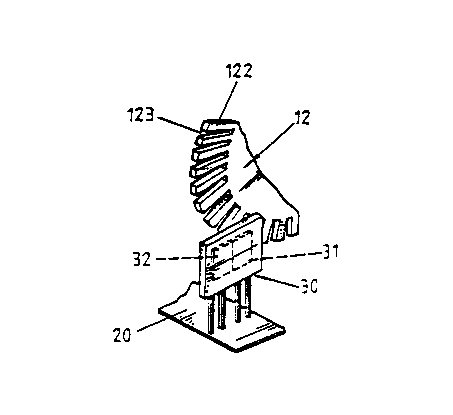Some of the information on this Web page has been provided by external sources. The Government of Canada is not responsible for the accuracy, reliability or currency of the information supplied by external sources. Users wishing to rely upon this information should consult directly with the source of the information. Content provided by external sources is not subject to official languages, privacy and accessibility requirements.
Any discrepancies in the text and image of the Claims and Abstract are due to differing posting times. Text of the Claims and Abstract are posted:
| (12) Patent Application: | (11) CA 2277672 |
|---|---|
| (54) English Title: | UNITARY PHOTO-ELECTRICAL COMPONENT |
| (54) French Title: | COMPOSANTE UNITAIRE PHOTO-ELECTRIQUE |
| Status: | Deemed Abandoned and Beyond the Period of Reinstatement - Pending Response to Notice of Disregarded Communication |
| (51) International Patent Classification (IPC): |
|
|---|---|
| (72) Inventors : |
|
| (73) Owners : |
|
| (71) Applicants : |
|
| (74) Agent: | RICHES, MCKENZIE & HERBERT LLP |
| (74) Associate agent: | |
| (45) Issued: | |
| (22) Filed Date: | 1999-07-14 |
| (41) Open to Public Inspection: | 2001-01-14 |
| Examination requested: | 1999-09-16 |
| Availability of licence: | N/A |
| Dedicated to the Public: | N/A |
| (25) Language of filing: | English |
| Patent Cooperation Treaty (PCT): | No |
|---|
| (30) Application Priority Data: | None |
|---|
The present invention relates to an improved structure of a shield used in a
computer mouse. The shield includes a generating part and a receiving part
which are
formed by integration and arranged linearly for constructing the reflecting
shield for
the mouse. To make the manual work for inserting the shield into the circuit
board of
the mouse can be done by just one action of composition to avoid the time of
actions
of repeatedly inserting electrical elements into the circuit board and to
reduce the
production cost.
Note: Claims are shown in the official language in which they were submitted.
Note: Descriptions are shown in the official language in which they were submitted.

2024-08-01:As part of the Next Generation Patents (NGP) transition, the Canadian Patents Database (CPD) now contains a more detailed Event History, which replicates the Event Log of our new back-office solution.
Please note that "Inactive:" events refers to events no longer in use in our new back-office solution.
For a clearer understanding of the status of the application/patent presented on this page, the site Disclaimer , as well as the definitions for Patent , Event History , Maintenance Fee and Payment History should be consulted.
| Description | Date |
|---|---|
| Inactive: IPC assigned | 2013-02-01 |
| Inactive: First IPC assigned | 2013-02-01 |
| Inactive: IPC assigned | 2013-02-01 |
| Inactive: IPC expired | 2013-01-01 |
| Inactive: IPC removed | 2012-12-31 |
| Inactive: IPC deactivated | 2011-07-29 |
| Inactive: First IPC derived | 2006-03-12 |
| Inactive: IPC from MCD | 2006-03-12 |
| Application Not Reinstated by Deadline | 2004-07-14 |
| Time Limit for Reversal Expired | 2004-07-14 |
| Deemed Abandoned - Conditions for Grant Determined Not Compliant | 2003-12-01 |
| Deemed Abandoned - Failure to Respond to Maintenance Fee Notice | 2003-07-14 |
| Notice of Allowance is Issued | 2003-05-29 |
| Letter Sent | 2003-05-29 |
| Notice of Allowance is Issued | 2003-05-29 |
| Inactive: Approved for allowance (AFA) | 2003-05-02 |
| Amendment Received - Voluntary Amendment | 2002-05-13 |
| Inactive: S.30(2) Rules - Examiner requisition | 2002-01-21 |
| Inactive: Cover page published | 2001-01-14 |
| Application Published (Open to Public Inspection) | 2001-01-14 |
| Letter Sent | 2000-07-12 |
| Inactive: Single transfer | 2000-06-13 |
| Inactive: Courtesy letter - Evidence | 2000-06-01 |
| Inactive: Single transfer | 2000-04-25 |
| Inactive: Application prosecuted on TS as of Log entry date | 1999-10-06 |
| Letter Sent | 1999-10-06 |
| Inactive: Status info is complete as of Log entry date | 1999-10-06 |
| Inactive: First IPC assigned | 1999-09-17 |
| Request for Examination Received | 1999-09-16 |
| Request for Examination Requirements Determined Compliant | 1999-09-16 |
| All Requirements for Examination Determined Compliant | 1999-09-16 |
| All Requirements for Examination Determined Compliant | 1999-09-16 |
| Inactive: Courtesy letter - Evidence | 1999-08-24 |
| Inactive: Filing certificate - No RFE (English) | 1999-08-20 |
| Filing Requirements Determined Compliant | 1999-08-20 |
| Application Received - Regular National | 1999-08-19 |
| Abandonment Date | Reason | Reinstatement Date |
|---|---|---|
| 2003-12-01 | ||
| 2003-07-14 |
The last payment was received on 2001-06-08
Note : If the full payment has not been received on or before the date indicated, a further fee may be required which may be one of the following
Please refer to the CIPO Patent Fees web page to see all current fee amounts.
| Fee Type | Anniversary Year | Due Date | Paid Date |
|---|---|---|---|
| Application fee - small | 1999-07-14 | ||
| Registration of a document | 1999-07-14 | ||
| Request for examination - small | 1999-09-16 | ||
| MF (application, 2nd anniv.) - small | 02 | 2001-07-16 | 2001-06-08 |
Note: Records showing the ownership history in alphabetical order.
| Current Owners on Record |
|---|
| UNITY OPTO TECHNOLOGY CO., LTD. |
| Past Owners on Record |
|---|
| ANDREW LIANG |
| KAY CHIN |